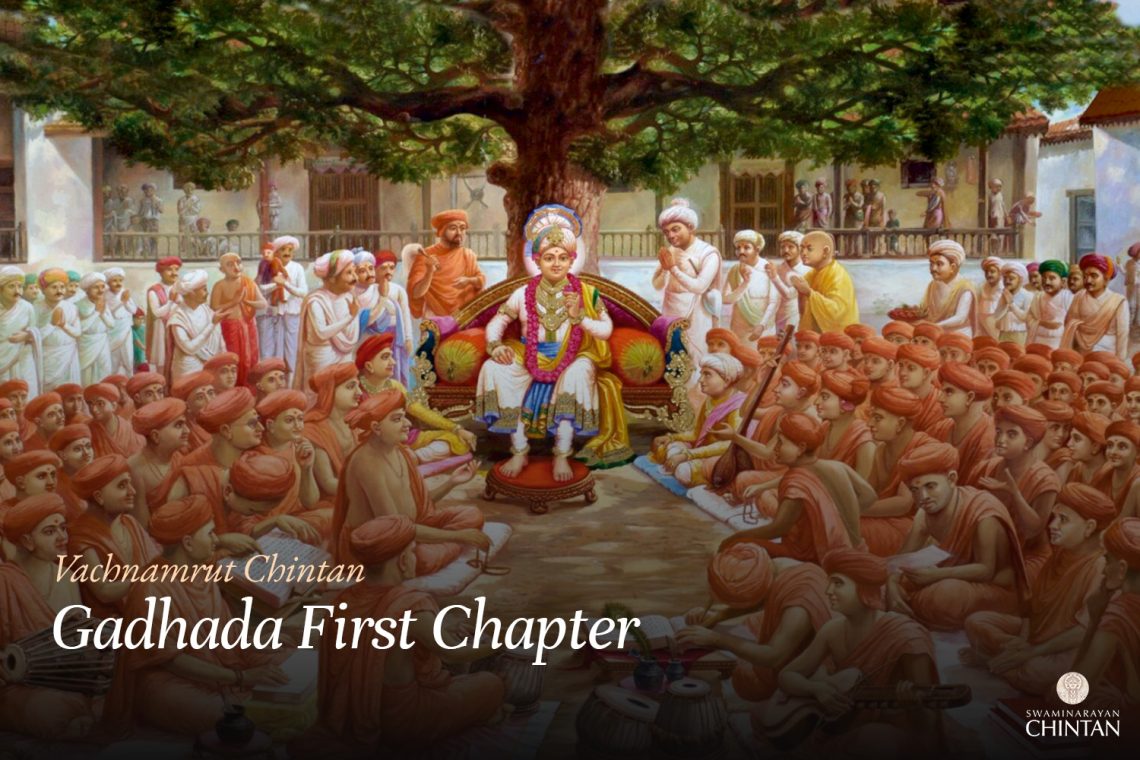Central Insights:
- How is Bhagawat Dharma nourished and the doors to salvation(Mōkṣha) opened?
Key Points:
- Ways to approach bhagwan is defined as Bhagawat Dharma
- That way is nourished by the Ekantik saint.
- Attachment to the world closes the door of salvation.
- Attachment to bhagwan and saints opens the door to salvation.
Explanation
This Vachanāmrut is about nourishing Bhagwat Dharma and opening the doors to salvation (Mōkṣha). In this Vachanāmrut, Muktanand Swami asks: “How is Bhagwat Dharma nourished, as mentioned in the 11th canto of the Shrimad Bhagwat in the discourse between King Janak and the nine Yogeshwars, and how is the door to salvation for Jiva opened?”
Shreeji Māharāj replies: “Nourishment of Bhagwat Dharma is done by the solidarity of the soul with saints (Prasang) who possess Swadharma (swa-self, Dharma-commands of God), Gyan (knowledge), Vairagya (non-attachment), and Bhakti (devotion) with knowledge of the greatness of God. Also, the door to salvation for Jiva gets opened by the Prasang of those saints. Kapildev Bhagwan said,
प्रसंगमजरं पाशमात्मनः कवयो विदुः।
स एव साधुषु कृतो मोक्षद्वारमपावृतम् ॥
prasaṅgam ajaraṁ pāśam ātmanaḥ kavayo viduḥ |
sa eva sādhuṣu kṛto mokṣadvāram apāvṛtam |
(Bhagwat 3:25:20)
The door to salvation gets opened when Jiva makes strong Prasang with Ekantik saints like it has with the relatives of its body.
Now, what is Bhagwat Dharma? The means by which Jiva can obtain God—those virtues or actions—are called Bhagwat Dharma. The means by which one can attain Akshardham and stay in the service of God is called Bhagwat Dharma. Surrendering everything to God by expressing feelings of the soul, performing Bhakti of nine types, and Satsang are the definition of Bhagwat Dharma. Maharaj said Bhagwat Dharma or Ekantik Dharma to four means: Dharma, Gyan, Vairagya, and Bhakti. Bhagwat Dharma is complete when all four means are complete; otherwise, it is incomplete.”
How is the above mentioned bhagwat dharma nourished?
The nourishment of Bhagwat Dharma is done by the Prasang of the soul with those Ekantik saints, and the door to salvation gets opened. What is the door to salvation? Is there a strong door and arrangement of lock and key at Akshardham to open the gate? There, what is the door? प्रसंगम् अजरम् पाशम् prasaṅgam ajaraṃ pāśam This Jiva has strong attachment to the body and relatives of the body like a door of iron. The iron door gets old but this attachment never gets old. New sprouts are always coming out. Thus, that door is difficult to open. How does it open? When one makes Prasang with Ekantik saints of God and destroys the Prasang with relatives, the door opens.
Here, there is also one point to think about in the shloka
प्रसंगम् अजरम् पाशम्
prasaṅgam ajaraṃ pāśam shloka
and
यस्यात्मबुद्धि कुणपे त्रिधातुके
yasyātma-buddhiḥ kuṇape tri-dhātuke
the first place for the attachment for salvation is shown to Ekantik saints of God. Not only said by Maharaj, but Vyasji also mentions that point by both shlokas. The point to think is the center of attachment should only be Maharaj; then why is he showing saints as a center? The reason only knows Maharaj, but it is reality that the center of attachment is saints. The attachment and faith in the Ekantik saints of God is the sowing of seeds of salvation. There is no doubt that if one has attachment to saints, then it gets converted into God as well
It is not a problem when the Prasang of a true saint is done. If there is an objection with a saint and perhaps love in God, then it spoils the salvation. Thus, the center of salvation is a true saint. A saint is not God but its replica. They are suitable to serve with devotion like God. On the other hand, the saint has the only goal to connect Jiva in God who is connected with him. If there is a saint who takes leverage of a new Jiva worthy of salvation, then he is not a saint.
In the second part of the Vachanamrut, there is a question from Shukmuni: “What are the characteristics of one who never recedes from Dharma even in a situation of emergency? What is the identification of perseverant Dharma?”
Maharaj says: “One whose nature is diligent and cannot disobey small and big commands of God, and does not recede from Dharma even in emergency situations. For diligence in Dharma, faith is needed. Sometimes, generous understanding makes Dharma weak. It makes diligent nature weak. Secondly, we are doing much for salvation. If there is some relaxation, then what happens? One cannot become strong in Dharma who has this kind of irrelevant generous understanding. He will not have the diligent nature as mentioned by Maharaj. Thus, pious people do not have options for behavior. They possess a strong belief of compulsorily doing what must be done. Thus, it feels rigorous to people with generous understanding. Also, it should be watched if there is rigidity in the name of perseverant Dharma. Perseverance is necessary but not rigidity. Also, one who possesses diligent perseverance, his Satsang becomes stronger.
Glossary
| Ajara Pash – An unaging bond or attachment. |
| Attachment – Clinging to sensory pleasures A tendency of the mind to become absorbed in pleasant objects, diverting the jeev from spiritual welfare. |
| Bhakti – Devotion Loving and selfless worship of God. |
| Diligent Perseverance – Strict adherence to God’s commands and Dharma, even during challenging times. |
| Ekantik Dharma – Single- minded, holistic devotion A combination of dharma, gyan (knowledge), vairagya (detachment), and bhakti (devotion), leading to liberation. |
| Ekantik Saints – Saints who embody Dharma, Gyan, Vairagya, and Bhakti, and have unwavering devotion to God. |
| Generous Understanding – A mindset that compromises strict adherence to Dharma. |
| Gyan – Knowledge, especially of God’s greatness and one’s own soul. |
| Gyani – A devotee with knowledge of God’s true greatness and no desires other than God. |
| Kapildev Bhagwan – A sage and incarnation of God who taught the principles of Bhagwat Dharma. |
| Moksh – Salvation or liberation from the cycle of birth and death. |
| Prasang – Attachment or strong connection. |
| Prasangam Ajaram Pasham – An unbreakable attachment that connects the soul to either worldly objects or saints. |
| Salvation (Moksh) – Liberation from material existence and union with God. |
| Satsang – Association with saints and devotees of God, or spiritual fellowship. |
| Swadharma – One’s righteous duty The moral and spiritual obligations a person must follow according to their role in life. |
| Vairagya – Detachment From Everything Except God |

